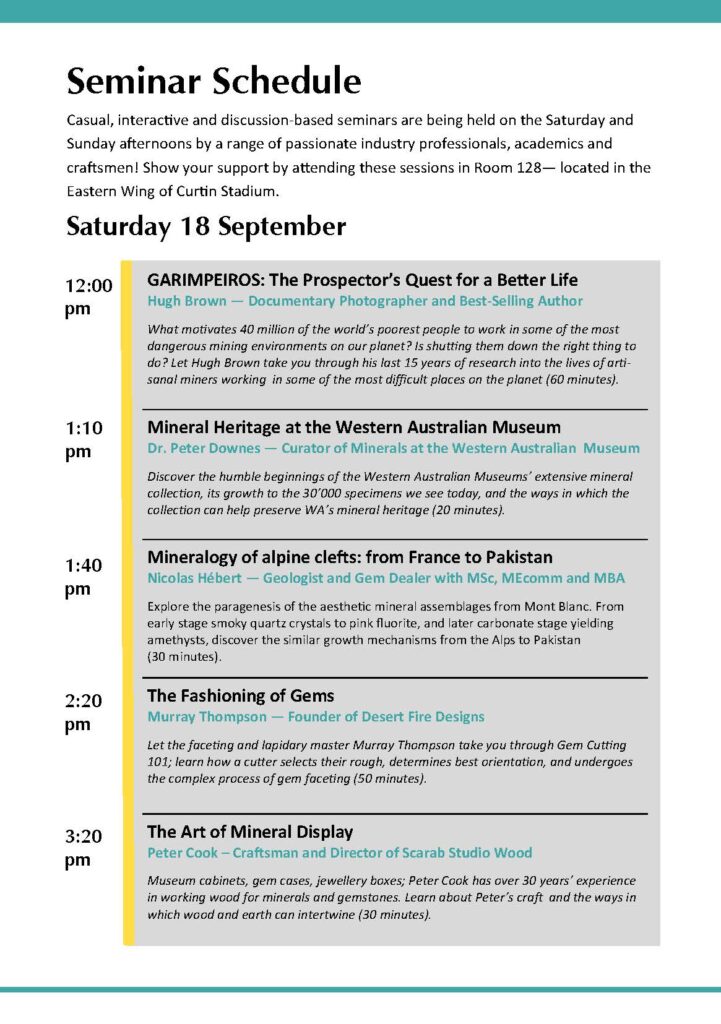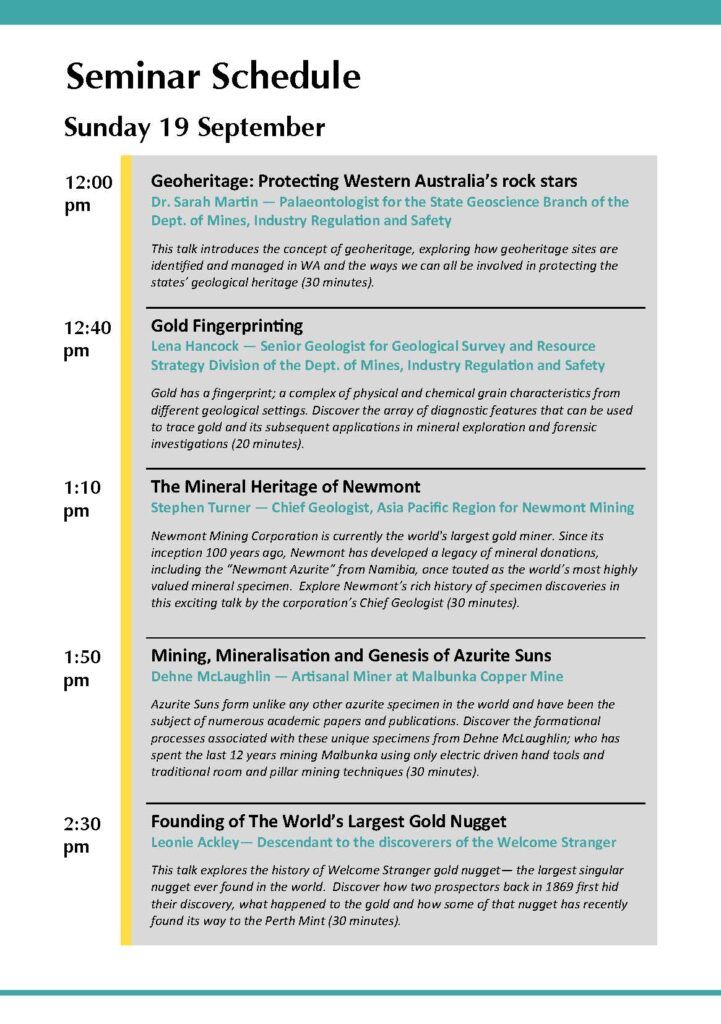Taking expression of interest for 2025 speakers :
Seminar
Keen on giving a talk?
The PGMS committee is looking for motivated presenters to be part of our seminar / conference event.
This year’s theme is around “Granite-related minerals”, but you’re obviously welcome to push the boundaries a bit.
The presentation/workshop space provided can hold up to 30 people, including large tables for workshopping and discussions. A lectern, projector, laptop, speakers and microphone will be provided, though presenters may choose to use their own laptop (with HDMI port) if preferred.
Presentations and/or workshops should run anywhere from 20 – 90 minutes and provide informative, creative and progressive aspects of the mineral world.
Examples include:
- A company or independent who has made a concerted effort to conserve mineral heritage – how did you do it?
- Individuals involved in the preparation of specimens or the curation of collection(s)
- Memoirs of a professional in the field
- Experts/academics presenting on their field
- Institution representative talking about science, education and communication
All submissions will be considered!
Examples below of past talks given in the 2023 & 2024 editions
Interested in running a workshop?
In addition to the speaker presentations, we are pleased to be able to provide a classroom space that will allow for hands-on workshops to be presented by individuals or businesses that are seeking a more interactive environment. Examples include:
- Jewellery Making
- Microscope Petrology 101
- Geoscience for Kids
Workshop scheduling, room requirements and exclusivity will be coordinated based on the expressions of interest received.
If this sounds like something you’d like to be involved in, please contact us!
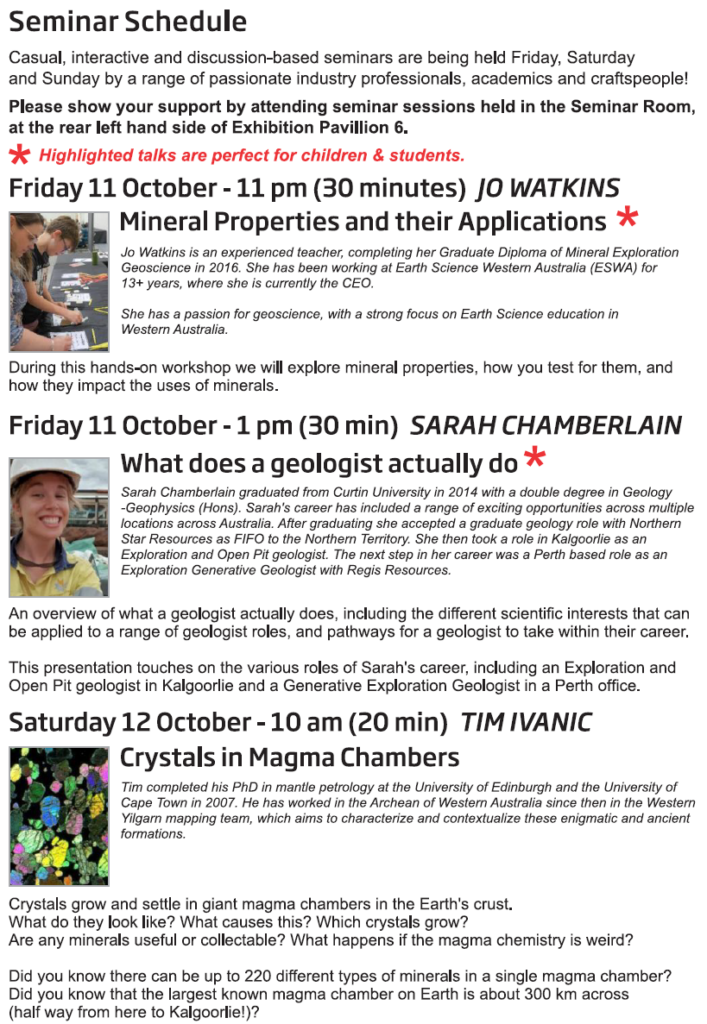
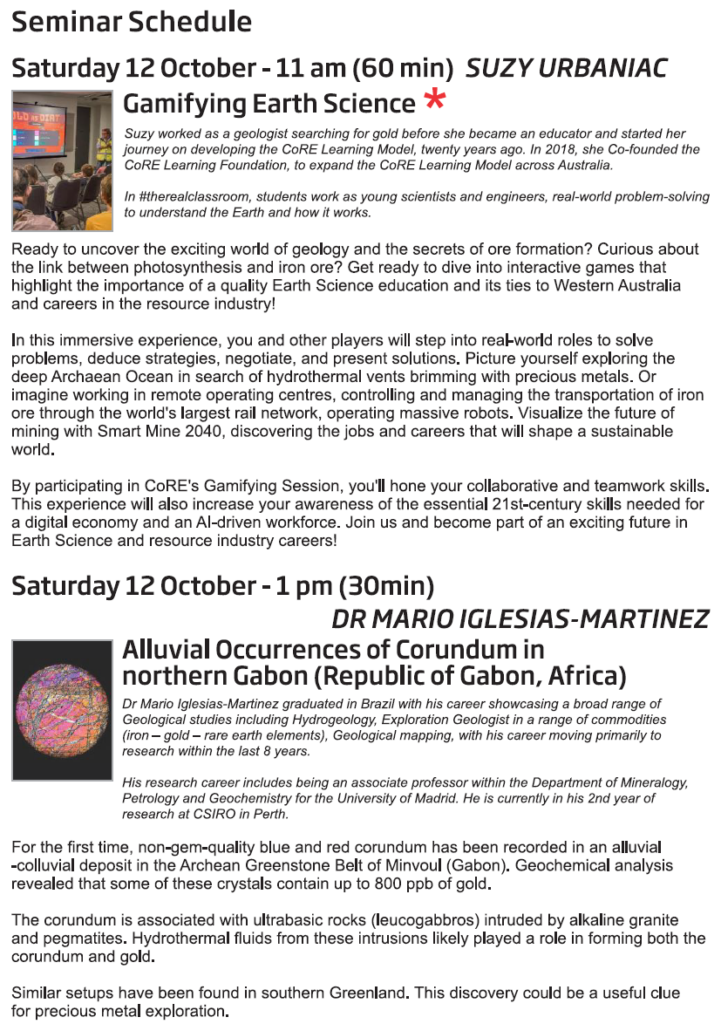
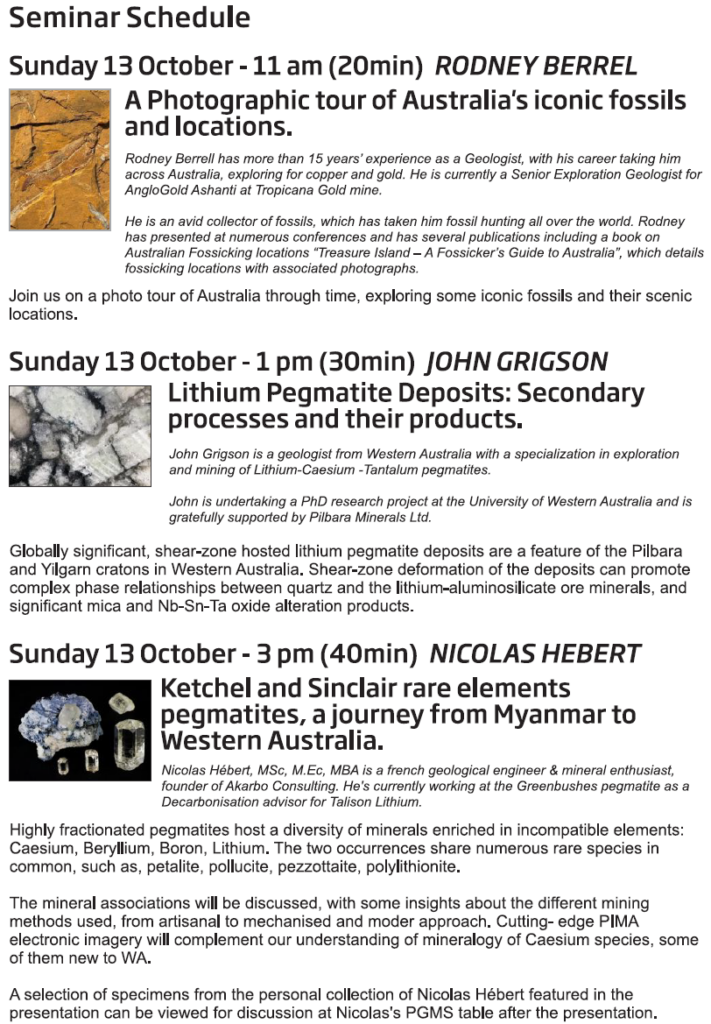
An appetite for apatite
Anthony Clarke
15 minutes
Apatite is often mistaken for other minerals, hence the origin of its name from the Greek “ἀπατάω”, meaning to deceive. Nevertheless, apatite is a powerful tool for understanding our planet, from timing gold mineralisation to tracking sediment flux across continents.
With its unique properties, apatite can store a wealth of geological information. I attempt to unlock this geological record and integrate insights from apatite with those from other minerals, thereby gaining a more comprehensive understanding of geological processes. Join me as I share research that has spanned the world, from the Pilbara, Welsh coastline, to the icecaps of Greenland.
Anthony Clarke is Welsh PhD student in applied geology at Curtin University. He completed his BSc at the University of St. Andrews, then postgraduate study at the Camborne School of Mines.
The giant Pilgangoora lithium pegmatite deposit
John Grigson
20 minutes
Pilgangoora is situated in the East Pilbara region of Western Australia and is one of the largest deposits of lithium globally. The deposit is shear zone hosted and comprises stacks of pegmatite intrusions that are hundreds of meters long and tens of meters thick.
The pegmatite intrusions have an incredible range of crystal size (1mm to 1m) and contain both common granitic minerals such as quartz, feldspar and mica as well as an abundance of rare metal-bearing minerals such as spodumene (lithium pyroxene). This presentation will define the geological setting at Pilgangoora and the evolution of minerals and metals in the pegmatite intrusions.
John Grigson is a geologist from Western Australia with a specialisation in exploration and mining of lithium-caesium-tantalum pegmatites. John is undertaking a PhD research project at the University of Western Australia and is gratefully supported by Pilbara Minerals Ltd.
Mineralogy of alpine clefts: from France to Pakistan
Nicolas Hébert
30 minutes
Explore the paragenesis of the aesthetic mineral assemblages from Mont Blanc. From early stage smoky quartz crystals to pink fluorite, and later carbonate stage yielding amethysts, discover the similar growth mechanisms from the Alps to Pakistan
Nicolas Hébert, MSc, M.Ec, MBA is a french geological engineer & mineral enthusiast, founder of Akarbo resources. He’s currently working at the Greenbushes pegmatite as a data analyst for Talison Lithium.
Gamifying Earth Science
Jett Coletti
60 minutes
The CoRE Learning Foundation has developed two games – Resource, Rescue and Respond on Minecraft and Old as Dirt, a unity web based party game suite, to create a greater awareness of the importance of an Earth Science education, and how student learning in context can be connected to the diversity of careers in the resources industry.
During this presentation, the audience will engage in playing some of Old as Dirt, mini games that explore and immerse the students in the world of ore formation, exploration, transport and export in addition to being shown Resource, Rescue and Respond, a highly detailed, comprehensive experience described through a mine site’s Emergency Response Training Program.
The games have been designed to be assessable and reportable, and are representative of the Australian Curriculum. Student’s thoroughly enjoy playing these games, developing not only their STEM skills but also understanding how their learning connects to real world industry and career pathways.
Jett is the Business Development Officer at the CoRE Learning Foundation and is instrumental in ensuring the evolution and growth of the Foundation’s Gamifying Earth Science Initiative.
He is a CoRE Alumni, who first-hand experienced the benefits and rewards of STEM learning through the CoRE Learning Model. As a result, Jett, initially volunteered for the Foundation, and now is spearheading its not for profit expansion across Australia.
Every Rock Tells a Story ! I love granites
Suzy Urbaniak
30 minutes
Every Rock tells a story! Look at the colours. What do they mean ? How many different colours are there?Let’s take a deep dive into a rock and look at its chemistry, physics and sometimes biology, to understand the world of elements, minerals and rocks.
Here in Western Australia, there is a lot of granite but is it the same and why is it different ? How did it form and why is it so special? We will look at concepts such as xenoliths, lustre, crystal shape, tafone and even the formation of the iconic ‘wave,’ a geomorphological feature that characterises the granitic landscape of the Yilgarn Craton.
” A rock, ain’t just a rock. It is so much more ! “
Suzy worked as a geologist searching for gold before she became an educator and started her journey on developing the CoRE Learning Model, twenty years ago. In #therealclassroom, students work as young scientists and engineers, real-world problem-solving to understand the Earth and how it works. In 2018, she Co-founded the CoRE Learning Foundation, to expand the CoRE Learning Model across Australia
Panasqueira, a collectors’ wonderland for quartz and dark minerals. Stubborn paragenesis and hydrothermal source enigmas
Dehne McLaughlin
45 minutes
The Tungsten/Tin/Copper mines of the Panasqueira mining area in Portugal have attracted commercial, academic and mineral collector interest for over 100 years. Panasqueira hosts the 9th largest wolfram deposit in the world which on current rates of production has only 20 years of mine life remaining. Tungsten in the form of wolframite, mainly as ferberite, plus tin minerals and chalcopyrite, occupies numerous (¬1500) sub horizontal quartz rich veins up to a metre thick in metasediments sitting above a granite intrusion with a greisenised cupola.
There has been at least 4 major high pressure hydrostatic and hydrothermal mineralising events (some researchers advise up to 7 events) that have opened up the quartz veins to crystallisation of a complex of minerals such as topaz, F-apatite, siderite, ferberite/wolframite, cassiterite, tourmaline, muscovite, chalcopyrite, sphalerite, pyrite, marcasite, stannite, siderite, dolomite, calcite, arsenopyrite, fluorite, and the ubiquitous quartz. The glamour mineralising event for collectors occurred at a later stage when hot fluids dissolved out open spaces in many of the veins followed by free growth of mineral crystal combinations that are preserved in worldwide collections. The high quality mineral specimens presented in this talk are from 36 years of acquisition in the USA and Europe.
Dehne McLaughlin, a geologist and author from Hobart, is now a mineral collector disguised as a mineral dealer and has spent decades specialising in Portugal’s “Broken Hill” type location, Panasqueira. His career moved through geology, anthropology, biology, law, mine rehabilitation, mining and petroleum economics, finally ending up in consulting by 2000 that involved advising on resource agreements between Aboriginal traditional owners and resource companies. His ethos is Biblically based.
SiO2 minerals
Niels Dahl
45 minutes
Silicon dioxide is very common in the crust of the Earth as rock forming quartz. It can also create stunningly beautiful specimens for mineral collectors as quartz, agate, opal and colorful cherts. Many varieties are semi-precious stones.
Niels graduated in geology from university of Copenhagen many years ago, but has spent most of his career as an exploration geologist in Australia. He has now retired.
Our 2022 speaker program :
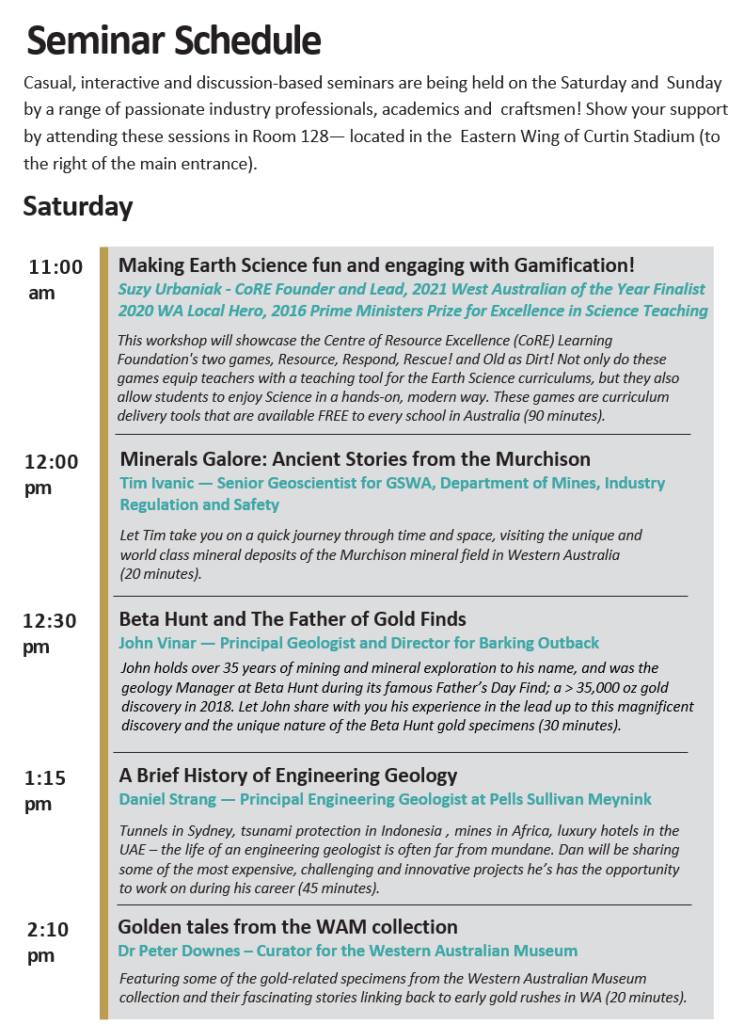
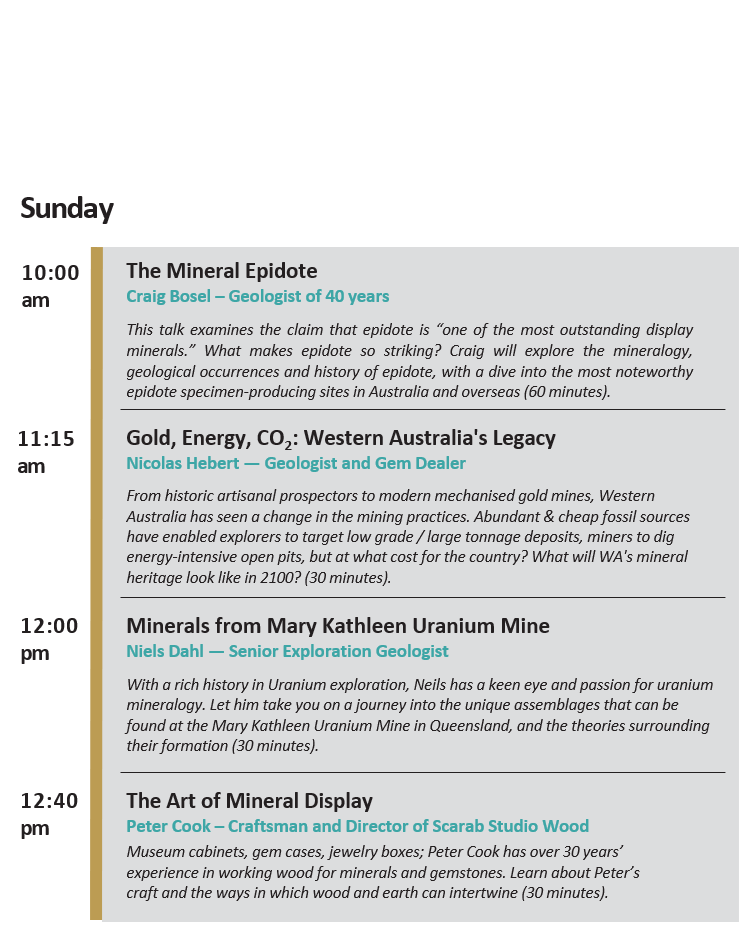
Our 2021 speaker program :
